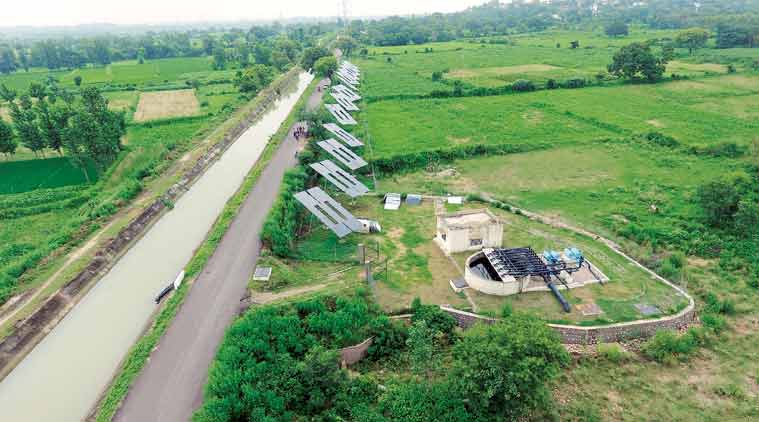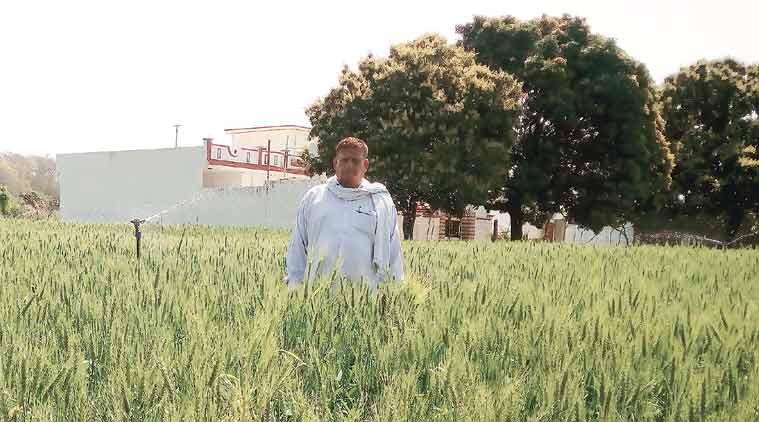 Solar panels and a pump house at a lifting point near the Kandi Canal in Punjab’s Hoshiarpur district. (Express Photo)
Solar panels and a pump house at a lifting point near the Kandi Canal in Punjab’s Hoshiarpur district. (Express Photo)
Raghvir Singh’s eight-acre field is less than half a km from the Kandi Canal and just over 20 km from the Shah Nahar barrage of the Pong Dam on the River Beas. Yet, this farmer from Kando Karora village in Mukerian tehsil of Hoshiarpur, till recently, had no access to water from the 130-km-long Canal, which is a branch of the Dam’s main Mukerian Hydel Channel. Nor was extraction of water by digging borewells possible, given that his field was at an
average 35 meter elevation relative to the canal and with also the presence of underground boulders.
But since October, Raghvir has actually started getting the Kandi Canal water, thanks to a solar-powered lift micro-irrigation project implemented by the Punjab government in 14 villages of Hoshiarpur district’s Talwara and Hajipur blocks. The project basically takes water from the Canal by siphons at three locations or lifting points. This water is collected in sump-wells at the points and filtered to remove sand particles, algae and other impurities. From there, it is then “lifted” using solar-powered submersible pumps to irrigate farmers’ fields directly, or to secondary level sump-wells for further lifting to other villages/farms within the project’s command area.
“This rabi (winter-spring) season is the first time when I have used irrigated water. Even my last 2017 kharif (post-monsoon) crop of bajra (pigeon-pea) was wholly rain-fed,” says Raghvir, who has just harvested 50 quintals of mustard from seven acres, besides growing chana (chickpea) and masur (lentil) on half-an-acre each. The new-found access to irrigation has already emboldened him to invest Rs 7.5 lakh in purchase of a 52-horsepower (HP) Massey Ferguson tractor. “I have made an upfront Rs 3 lakh cash payment and taken a bank loan of Rs 2.5 lakh. The rest Rs 2 lakh I shall pay to the dealer from my mustard crop proceeds,” he adds.
The Rs 41-crore project is currently delivering irrigated water to around 1,200 farmers in 664 hectares (1,641 acres), out of a total command area of 735 hectares that also includes land for habitation, roads, local ponds and other non-cultivable uses. It comprises five solar lift irrigation schemes at different levels of elevation and further divided into 18 zones of 35-40 hectares, with these, in turn, having 21 sections of 1.4-2.25 hectares each. In all, there are 3,798 solar panels with total 1.1 megawatt generation capacity and 46 pumps, each of 20-25 HP, which can lift 15.734 cusecs (cubic foot per second) of water for eight hours from the Kandi Canal.
The Kandi Canal — its construction was taken up in 1978 and the second phase completed only in mid-2016 — was meant to irrigate areas falling along the Shivalik foothills in Hoshiarpur and Nawanshahr districts. However, the project has benefited only farmers on the right side of the Canal that extends from Talwara (near Pong Dam) to Balachaur in Nawanshahr. Those on the left side haven’t been as lucky, since their fields are at a higher elevation than the Canal. Conventional diesel motor/electric power-based lift irrigation schemes for taking water to these undulating and sub-mountainous tracts, too, have failed, given the sheer financial costs involved.
 Captain Mukhtiar Singh at his sprinkler-irrigated wheat field in Jugial village of Hoshiarpur. (Photo: Harish Damodaran)
Captain Mukhtiar Singh at his sprinkler-irrigated wheat field in Jugial village of Hoshiarpur. (Photo: Harish Damodaran)
“Here, not only are we using solar power to lift the Canal water up to 100 meters height, but it is being combined with drip and sprinkler irrigation. Also, the entire water, right from the Canal source to farmers’ fields, is conveyed through underground HDPE (high-density polyethylene) and PVC (polyvinyl chlorine) pipe networks. That makes it the first project of its kind in the world,” claims Balwinder Singh Sidhu, Agriculture Commissioner and Chief Conservator of Soils, Punjab government. On the whole, the project has used some 8.6 km of HDPE pipes and 356.5 km of PVC lines of 180-450 mm and 63-180 mm diameter, respectively.
The project’s other unique feature is its being operated by a cloud-based software. Every field has a manual valve that a farmer can open/shut to allow/stop water to flow in whenever he wants. But there are also separate valves for each of the 1.4-2.25 hectares sections, connected to automatic controllers. These remote terminal units are further connected to base stations, which relay the signals for closing or opening of the sectional valves as per the demand in the fields and water levels in the sump-wells. When farmers are not using water, the pressure in the distribution lines rises. The pressure sensors at the pump-houses, then, signal opening of the relief valves to release the water back to the sump-wells. Similarly, in case of low water levels in the sumps, the solar photovoltaic pumps get automatically turned on.
“The system is designed to pump water for eight hours daily, while the requirement of farmers for cropping is for only 280-odd days. Counting the remaining days of the year, plus the few hours even during the cropping season when the pumps aren’t running, we estimate roughly 25 per cent of surplus solar power generation that could be exported to the grid and fund O&M (operation and maintenance) costs,” explains Sukhdeep Singh Duggal, senior engineer at Jain Irrigation Systems Ltd, which was awarded the contract to execute the project on turnkey basis.
Under the contract, the company is also responsible for O&M over a seven-year period from October 2017 and providing training to a farmers’ water user association to manage the project thereafter. How feasible that is going to be remains to be seen. For now, farmers aren’t complaining, though.
“We had practically given up agriculture, as everything was in the hands of qudrat (nature). This project has made a huge difference,” notes Mukhtiar Singh, a retired honorary captain who farms six acres in Jugial village of Hajipur tehsil. He is confident that the standing wheat crop on his four acres – in addition to one acre each under mustard and berseem green fodder – will yield 17-18 quintals per acre, “whereas I would have been lucky previously to get even eight quintals”.
Assured irrigation has, however, also raised expectations. Farmers in Punjab’s Kandi area, being in the vicinity of forests along the Shivalik hills, regularly suffer crop damage from wild boars, nilgai (blue bull) and barasingha or sambar deers. Since that possibility is higher when crop yields go up, the project has additionally provided for a 15.3-km-long chain-link fence at eight meters height. “It has, no doubt, taken care of the threat from wild animals. But today, our real problem is from awara pashu (stray cattle). We want government subsidy to build fences around our individual fields to prevent their entry. The cost of such fencing would be over Rs 1 lakh per acre,” demands Shashi Thakur, a 30-acre farmer from Sawar village in Hajipur tehsil.
The success of the solar-powered lift micro-irrigation project has, not surprisingly, fuelled demands for its replication in other villages on the left side of the Kandi Canal. “Why can’t government implement this in our village?” asks Havaldar Krishan Singh, whose seven-acre field in Siprian village of Hajipur tehsil is completely rain-fed.
Sidhu, on his part, concedes that “our department has received applications from 40 villages in this belt”. He believes that Punjab’s future lies is making better use of canal water from projects such as the Pong, Bhakra-Nangal (on the Sutlej) and Ranjit Sagar/Thein (Ravi) dams.
“It is tragic that canals now meet only 27 per cent of the state’s irrigation needs. The balance 73 per cent is from groundwater extracted through free power that costs the government Rs 5,700 crore annually. The ratio should be the other way round. The money spent on power subsidy can better be used to improve the efficiency and coverage of our canal systems, including through HDPE/PVC piping networks and solar lift irrigation schemes,” points out Sidhu.